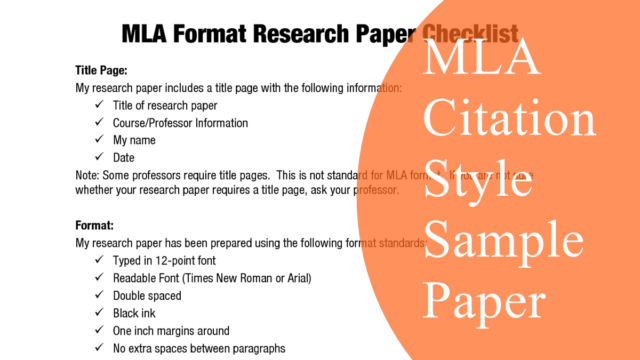The Modern Language Association provides standards for acknowledging the sources that scholars use in research papers. MLA citation format uses a coherent system of two-part parenthetical documentation for citations: citations within the text specify the alphabetical list on the Works Cited page at the end of the work. Altogether, such references identify and credit the sources, allowing everyone to access and retrieve the material. Read more about MLA citation style on wr1ter.com.
MLA Sample Paper Guidelines
In MLA citation format, scholars must place the references to sources in the text to shortly identify them, enabling the readers to find them on the Works Cited page. Such parenthetical references must be kept as clear and brief as possible:
– Provide only the information that identifies the source. Typically, it’s the author’s last name and a page or pages reference:
E.g., These hypotheses (Rogers and Bradley 8) suggested the following theory (Reichl, Waugh, and Sumner 25).
In case there is more than one citation, the scholar must indicate both:
E.g., (Thomas 53; Burns 245)
When one cites corporate authors, the parenthetical statement must look like this:
E.g., (United Nations, Educational Commission for Africa 54-62)
Any references to a volume and pages must look like this:
E.g., ( Henderson 3: 2-17)
Any citations to the whole work must look like this:
(Wilson, vol. 2)
– One should put the parenthetical references as near as possible to its source. Locate them at the end of a sentence or where a pause would naturally occur:
E.g., These concerns have been expressed (Rover 119-22).
– All information in the parenthesis must complement but not repeat the information in the text. When you write the author’s name in a sentence, there is no need to repeat it in parenthesis:
E.g., Rover has expressed these concerns (119-22).
In case there are two locations of the citation, one should indicate both:
E.g., Williams pointed to this premise (137-38, 146).
If the text reference is to an entire volume, one must not repeat it in parenthesis:
E.g., In volume 4, Burns suggests that…
– Any parenthetical reference must precede the punctuation mark at the end of the phrase, sentence, or clause with the citation.
– For online or electronic sources quotation, one must place the origin in parenthesis. When an online source comprises a fixed section or page numbering (e.g., numbering of paragraphs), mention them in parenthetical references. If an online source does not have a page number, do not put anything in parenthesis.
E.g., (Fox, pars. 5-6)
– For citations with no author, one must use either the full or shortened work’s title. In case of abbreviating a title, one must omit the initial articles and start with the word by which the reference is the Works Cited list:
E.g., as states the parliamentary commission (Report 3).
Scholars must place the references at the end of the paper’s bibliography or Works Cited page in the MLA citation format. This list must provide the information significant to identify and retrieve every source, which supports the research.
– Arrange all references in alphabetical order by the authors’ last names. For sources without the author, arrange them by the title.
– Capitalize the first and all the principal words of the subtitles and titles. Never capitalize prepositions, articles, coordinating conjunctions, and the “to” in infinitive forms.
– Compress the publisher’s name, omitting articles, or use descriptive words (Publisher, Press) and business abbreviations (Inc., Co.).
– When you list multiple publishers, include each of them and place a semicolon between them.
– When you list more than one city for the same publisher, write only the first one.
– When listing several authors of a single work, always use the conjunction “and,” but not an ampersand [&].
– Never use the abbreviations pp. or p. to designate page numbers.
– Always align the first line of the entry flush with the left margin, and indent all subsequent lines (5-7 spaces) to form a “hanging indent.”
– Always choose a font that contrasts clearly with the regular for the italic style.
E.g., Hoffman, Susan, and Christine Cross. Bruce Nauman: Theaters of Experience. New York: Guggenheim Museum; London: Thames & Hudson, 2006 Print.
Hunt, Tim. “The Misreading of Kerouac.” Review of Contemporary Fiction 3.2 (1983): 29-33. Rpt. in Contemporary Literary Criticism. Ed. Carl Riley. Vol. 61. Detroit: Gale, 1990, 308-10. Print.
Tolstoi, Lev. War and Peace. New York: Putnam, 1975. Print.


